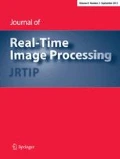Abstract
Halftone images are usually used in facsimile and halftone image steganography can be used for facsimile channel. In recent years, real-time image processing becomes more and more important. In this paper, an efficient block-based steganographic method for halftone images is proposed. This method is based on optimal dispersion degree (DD), which can measure the complexity of the region texture. To reduce the visual distortion, the blocks with complex texture can be selected as carriers according to the dispersion degree. Finally, the secret messages are embedded by flipping the pixels that can minimize the changes of texture structure. The experiments demonstrate that the proposed scheme maintains a good image visual quality and realizes acceptable statistical security with high capacity.





Similar content being viewed by others
References
Bas, P., Filler, T., Pevn, Y.T.: Break our steganographic system: the ins and outs of organizing boss. J. Am. Stat. Assoc. 96(454), 488–499 (2011)
Byun, J.Y., Jung, K.H., Yoo, K.Y.: Improved data hiding method by block parity for binary images. In: International Conference on Computer Science and Software Engineering, pp. 931–934 (2008)
Chen, J., Lu, W., Fang, Y., Liu, X., Yeung, Y., Xue, Y.: Binary image steganalysis based on local texture pattern. J. Vis. Commun. Image Represent. 55, 149–156 (2018)
Chen, J., Lu, W., Yeung, Y., Xue, Y., Liu, X., Lin, C., Zhang, Y.: Binary image steganalysis based on distortion level co-occurrence matrix. Comput. Mater. Contin. 55(2), 201–211 (2018)
Feng, B., Lu, W., Sun, W.: High capacity data hiding scheme for binary images based on minimizing flipping distortion. In: International Workshop on Digital Watermarking, pp. 514–528 (2013)
Feng, B., Lu, W., Sun, W.: Secure binary image steganography based on minimizing the distortion on the texture. IEEE Trans. Inf. Forensics Secur. 10(2), 243–255 (2014)
Feng, B., Lu, W., Sun, W.: Binary image steganalysis based on pixel mesh markov transition matrix. J. Vis. Commun. Image Represent. 26(C), 284–295 (2015)
Feng, B., Lu, W., Sun, W.: Novel steganographic method based on generalized k-distance n-dimensional pixel matching. Multimed. Tools Appl. 74(21), 9623–9646 (2015)
Feng, B., Lu, W., Sun, W., Liang, Z., Liu, J.: Blind watermarking based on adaptive lattice quantization index modulation. In: International Workshop on Digital Watermarking, pp. 239–249. Springer International Publishing, New York (2015)
Feng, B., Weng, J., Lu, W., Pei, B.: Multiple watermarking using multilevel quantization index modulation. In: International Workshop on Digital Watermarking, pp. 312–326 (2016)
Filler, T., Fridrich, J.: Design of adaptive steganographic schemes for digital images. Proc SPIE 7880(1), 181–197 (2011)
Floyd, R.W., Steinberg, L.: Adaptive algorithm for spatial greyscale. In: Proceedings of SID, pp. 75–77 (1976)
Fu, M.S., Au, O.C.: Halftone image data hiding with intensity selection and connection selection. Signal Process. Image Commun. 16(10), 909–930 (2001)
Guo, J.M., Tsai, J.J.: Data-hiding in halftone images using adaptive noise-balanced error diffusion. IEEE Multimed. 18(2), 48–59 (2010)
Guo, M., Zhang, H.: High capacity data hiding for halftone image authentication. In: International conference on digital forensics and watermarking, pp. 156–168 (2013)
Huang, F., Huang, J., Shi, Y.Q.: New channel selection rule for jpeg steganography. IEEE Trans. Inf. Forensics Secur. 7(4), 1181–1191 (2012)
Jarvis, J.F., Judice, C.N., Ninke, W.H.: A survey of techniques for the display of continuous tone pictures on bilevel displays. Comput. Graphics Image Process. 5(1), 13–40 (1976)
Kang, L.C., Pieprzyk, J.: Blind steganalysis: A countermeasure for binary image steganography. In: International Conference on Availability, Reliability, and Security, pp. 653–658 (2010)
Lin, X., Feng, B., Lu, W., Sun, W.: Content-adaptive residual for steganalysis. In: International Workshop on Digital Watermarking, pp. 389–398 (2014)
Lu, W., Sun, W., Chung, F.L., Lu, H.: Revealing digital fakery using multiresolution decomposition and higher order statistics. Eng. Appl. Artif. Intell. 24(4), 666–672 (2011)
Mei, Q.G., Wong, E.K., Memon, N.D.: Data hiding in binary text documents. Proc. SPIE 4314, 369–375 (2001)
Pei, S.C., Guo, J.M.: High-capacity data hiding in halftone images using minimal-error bit searching and least-mean square filter. IEEE Trans. Image Process. 15(6), 1665–1679 (2006)
Qin, C., Chang, C.C., Chiu, Y.P.: A novel joint data-hiding and compression scheme based on smvq and image inpainting. IEEE Trans. Image Process. 23(3), 969–78 (2014)
Qin, C., Chang, C.C., Huang, Y.H., Liao, L.T.: An inpainting-assisted reversible steganographic scheme using a histogram shifting mechanism. IEEE Trans. Circuits Syst. Video Technol. 23(7), 1109–1118 (2013)
Shapiro, L.: Digital halftoning: Robert ulichney. Comput. Vis. Graphics Image Process. 41(3), 382–382 (1988)
Yadav, G.S., Ojha, A.: A fast and efficient data hiding scheme in binary images. In: Eighth international conference on intelligent information hiding and multimedia signal processing, pp. 79–84 (2012)
Zhang, Y., Qin, C., Zhang, W., Liu, F., Luo, X.: On the fault-tolerant performance for a class of robust image steganography. Signal Process. 146, 99–111 (2018)
Acknowledgements
This work is supported by the National Natural Science Foundation of China (No. U1736118), the National Key R&D Program of China (No. 2017YFB0802500), the Natural Science Foundation of Guangdong (No. 2016A030313350), the Special Funds for Science and Technology Development of Guangdong (No. 2016KZ010103), the Key Project of Scientific Research Plan of Guangzhou (No. 201804020068), the Fundamental Research Funds for the Central Universities (No. 16lgjc83 and No. 17lgjc45).
Author information
Authors and Affiliations
Corresponding author
Rights and permissions
About this article
Cite this article
Xue, Y., Liu, W., Lu, W. et al. Efficient halftone image steganography based on dispersion degree optimization. J Real-Time Image Proc 16, 601–609 (2019). https://doi.org/10.1007/s11554-018-0822-8
Received:
Accepted:
Published:
Issue Date:
DOI: https://doi.org/10.1007/s11554-018-0822-8



